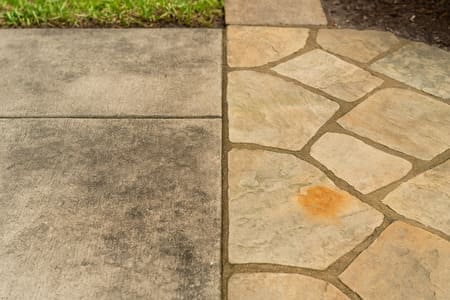Concrete vs. Stone: What Makes These Surfaces Dirty - and How We Clean Them Right

Concrete and stone surfaces play a major role in the appearance and safety of outdoor spaces. Whether you're dealing with a stamped concrete driveway, a natural stone patio, or a mixed-material walkway, these surfaces are exposed to the elements year-round. And while they may seem tough and durable, both materials are vulnerable to grime, stains, and weather-related buildup. The trick is understanding how each surface behaves - and why they require different cleaning techniques.
Porosity, Density, and Texture: Why It Matters
One of the biggest differences between concrete and natural stone is how they absorb and hold onto dirt. Concrete is man-made and relatively uniform, but it's still porous. It tends to absorb water, oil, and organic material, especially if it's unsealed. That leads to dark staining, mold growth, and slippery surfaces over time.
Stone, on the other hand, varies widely in porosity and density depending on the type - slate, limestone, granite, travertine, and flagstone all respond differently. Softer stones are more absorbent and prone to etching or flaking if cleaned improperly. The surface texture of natural stone also traps dirt more easily in grooves and fissures, making it harder to clean thoroughly without the right equipment.
Common Stains: Rust, Algae, Oil, and Hard Water
Both materials can fall victim to the same types of surface stains, but they absorb and display them differently. Algae and mildew thrive in damp, shaded areas and show up as green or black streaks on patios and walkways. Rust from metal patio furniture or irrigation systems can leave unsightly orange marks, while oil from vehicles or grills seeps into porous concrete and stone alike.
Hard water stains are another common issue, especially near fountains or pool areas. These mineral deposits leave chalky white films that dull the appearance of the surface and require specialized cleaners to remove safely.
The Pressure Washing Pitfall
Concrete cleaning is often done with high-pressure surface cleaners that remove buildup effectively without damaging the slab. However, the same approach can backfire on stone. Blasting softer stone with high pressure can cause pitting, chipping, or permanent damage. That's why we tailor every cleaning service based on material type, age, and finish.
For stone, especially when dealing with more delicate varieties or decorative finishes, we use soft washing methods and stone-safe cleaners that lift stains without aggressive force. When it comes to where surfaces are often a blend of concrete and stone, this dual-approach is especially important.
Cleaning Mixed-Surface Spaces the Right Way
Outdoor areas like patios, driveways, and pool decks often use a mix of concrete and stone. Using one method across the board can do more harm than good. Our team assesses the materials and selects the safest, most effective strategy for each one. That's what makes us Austin's premier choice for quality pressure washing.
Whether you're maintaining your home or prepping your property for sale, keeping stone and concrete clean protects your investment and enhances curb appeal. To schedule expert stone and concrete cleaning in Austin, make arrangements with us at Hill Country Exterior Restoration today.

Need Pressure Washing In Austin? Call The Experts Today!